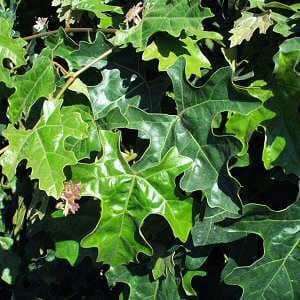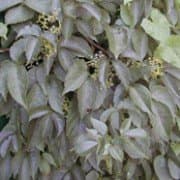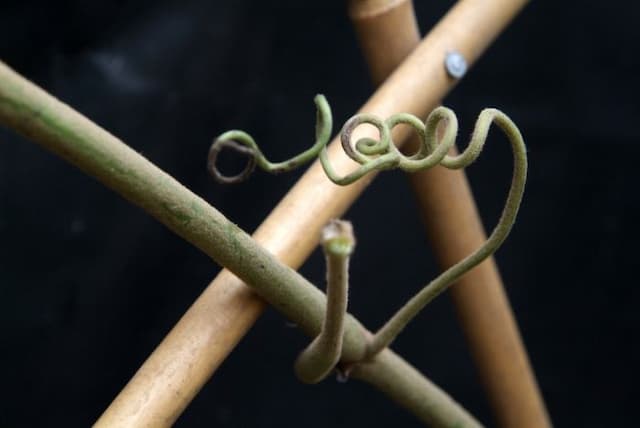Black Marseille grape Vitis vinifera 'Noir Hâtif de Marseille' (O/b)

ABOUT
Noir Hâtif de Marseille, commonly known as the grapevine, is a cultivated variety with distinct characteristics. This plant is known for its woody, twining growth habit, which often requires support structures such as trellises to maintain its sprawling form. The stems of the grapevine are long and can appear twisted or gnarled with age, featuring peeling bark that adds to its rustic charm. The leaves of the grapevine are large, lobed, and have toothed edges, displaying a vibrant green hue that turns to various shades of yellow or red come autumn, depending on the climate and environmental conditions. During the growing season, the grapevine produces clusters of small, greenish-white flowers that are quite inconspicuous. However, these flowers are vital as they give way to the plant's most renowned feature: bunches of succulent grapes. The grapes of the Noir Hâtif de Marseille are typically dark-colored, varying from deep purple to almost black in hue. These juicy fruits hang in clusters that can be quite heavy and dense when fully ripe. The grape skins are smooth, with a waxy coating and are enveloped by semi-transparent flesh encapsulating seeds within. These grapes are not only attractive but are also cultivated for various uses, including fresh consumption and winemaking. Overall, the appearance of the Noir Hâtif de Marseille grapevine is characterized by its vigorous growth, verdant foliage, and the attractive, dark grapes that dangle from the vines during the fruiting season.
About this plant
 Names
NamesSynonyms
Noir Hâtif de Marseille Grape, Early Black of Marseilles.
Common names
Vitis vinifera 'Noir Hâtif de Marseille'.
 Toxicity
ToxicityTo humans
The plant in question is a variety of common grape vine. In general, grapes and their parts are not considered toxic to humans and are widely consumed in various forms, such as fresh fruit, juice, and wine. However, individuals with specific conditions may be advised to limit or avoid grape consumption due to potential interactions or health issues. For instance, the skins of grapes contain resveratrol, which while beneficial in moderation could pose problems at high concentrations, particularly for those with hormone-sensitive conditions. It is also important to note that ingesting large amounts of grape seeds could potentially cause an intestinal blockage, but this is quite rare. The stems and leaves of the grape vine, while not commonly ingested, are also not considered toxic to humans.
To pets
The common grape vine is known to be toxic to pets, especially dogs and cats. The exact toxic compound in grapes is still unidentified, but ingestion of any part of the grape plant, particularly the fruit, can lead to rapid onset of symptoms such as vomiting, diarrhea, lethargy, abdominal pain, and lack of appetite. In severe cases, acute kidney failure can occur, which can be potentially fatal if not treated promptly. Even small amounts of grapes or raisins can be dangerous to pets, and prompt veterinary attention is required if ingestion is suspected. It is crucial to keep grapes and their products out of reach of pets to prevent such toxic incidents.
 Characteristics
CharacteristicsLife cycle
Perennials
Foliage type
Deciduous
Color of leaves
Green
Flower color
Greenish-white
Height
15-20 feet (4.5 - 6m)
Spread
15-20 feet (4.5 - 6m)
Plant type
Climber
Hardiness zones
7-10
Native area
Europe
Benefits
 General Benefits
General Benefits- Nutritional Value: 'Noir Hâtif de Marseille' grapes are a rich source of vitamins, antioxidants, and minerals essential for human health.
- Culinary Versatility: Can be used in various culinary applications, including fresh table grapes, raisins, jams, and wine production.
- Economic Benefit: Grape cultivation can be a profitable agricultural enterprise, contributing to local economies.
- Landscape Value: Offers aesthetic appeal to gardens and vineyards with its lush foliage and attractive fruit clusters.
- Shade Provision: The vine's extensive canopy can create shaded areas outdoors, enhancing comfort and reducing the need for artificial cooling.
- Habitat Support: Supports biodiversity by providing food and shelter for a range of insects and bird species.
- Cultural Significance: Cultivation and consumption have deep cultural and historic roots in many societies, often associated with tradition and heritage.
 Medical Properties
Medical Properties- Antioxidant: Grape berries and seeds from Vitis vinifera are rich in polyphenols that have antioxidant properties, helping to protect cells from oxidative stress.
- Cardiovascular health: Resveratrol and other compounds found in grapes may contribute to the maintenance of heart health by improving blood flow and reducing inflammation.
- Anti-inflammatory: The bioactive compounds in grapes have anti-inflammatory effects that may alleviate symptoms of certain inflammatory conditions.
- Antimicrobial: Grape seed extract has been studied for its potential antimicrobial properties against a variety of pathogens.
- Anti-cancer: Research suggests that certain compounds in grapes, like resveratrol, may have anti-cancer properties, though this is not confirmed for treatment use.
 Air-purifying Qualities
Air-purifying QualitiesThis plant is not specifically known for air purifying qualities.
 Other Uses
Other Uses- Dye Production: The skin of the grapes can be used to create a natural dye for fabrics or food coloring, providing a range of purple and blue hues.
- Photography: The tannins found in grapes can be used in the traditional process of making sepia-toned photographs.
- Water Retention Gel: Crushed grape seeds can be processed into a gel-like substance that helps soil retain water, benefiting gardening and agriculture.
- Vinegar Making: Overripe or leftover grapes from this vine can be fermented further to create grape vinegar, an alternative to traditional vinegar.
- Art Supplies: Extracts from the grapes can be mixed with other components to make natural watercolor or ink for artists.
- Craft Material: The vines, after pruning, can be woven into baskets, wreaths, and other decorative items.
- Insect Trap: The sweet juice of the grapes can be used to attract and trap fruit flies and other insects.
- Biodegradable Packing Material: Dried and ground vines can be shaped into eco-friendly packaging peanuts or pads as a cushioning material for shipping goods.
- Natural Sweetener: Dried grapes (raisins) can be used as a natural sweetener in various dishes, providing an alternative to refined sugar.
- Homemade Potpourri: Dried grape leaves and stems, along with other natural ingredients, can be used to create a fragrant potpourri for the home.
Interesting Facts
 Feng Shui
Feng ShuiThe grapevine is not used in Feng Shui practice.
 Zodiac Sign Compitability
Zodiac Sign CompitabilityThe grapevine is not used in astrology practice.
 Plant Symbolism
Plant Symbolism- Fertility and Abundance: As a grapevine, Vitis vinifera represents fruitfulness and plenty, often associated with the abundant harvest of grapes that yield wine and sustenance.
- Transformation and Celebration: The plant's conversion of grapes into wine symbolizes transformation and the joy of life; wine often accompanies celebrations and significant life events.
- Vitality and Life: The vigor of the grapevine and its deep connection to the earth symbolizes vitality and a life force that is maintained through seasons and cycles of growth.
- Prosperity and Wealth: Grapes have historically been seen as a sign of wealth, as vineyards and winemaking represented economic prosperity and the accumulation of riches.
 Water
WaterCommon grapevine (Vitis vinifera 'Noir Hâtif de Marseille') requires thorough watering, targeting the root zone, around once a week during the growing season, but frequency should be adjusted based on weather conditions and soil moisture levels. During the hot summer months, the plant may need additional water, so check the soil moisture and water when the top few inches are dry. Provide approximately 1-2 gallons per vine each time you water, ensuring that the water penetrates deeply to encourage strong root development. In the dormant winter season, reduce watering as the plant's water needs decrease significantly. Avoid overhead watering to prevent fungal diseases.
 Light
LightCommon grapevines prefer full sunlight with at least 6-8 hours of direct sun exposure daily. Plant the grapevine in a location where it receives ample morning sunlight, which helps to dry the dew on leaves, reducing the risk of fungal diseases. Avoid shaded areas as this can inhibit fruiting and lead to poor development of the vines.
 Temperature
TemperatureFor common grapevine, the ideal growing temperatures are between 60 to 85°F, with dormant period cold tolerance down to about 20°F for short periods, though some varieties may withstand slightly colder conditions. Temperatures over 95°F can inhibit fruit set and should be avoided. The plant's buds can be damaged by late spring frosts, so consider site selection carefully to avoid frost pockets.
 Pruning
PruningPrune common grapevines during the dormant season, typically late winter to early spring, to ensure a healthy structure and improve fruit quality. Remove dead or diseased wood, thin out overcrowded areas, and cut back last year's growth to maintain the shape of the vine and encourage new fruiting shoots. Pruning is critical for controlling the plant's size and vigor as well as for promoting good air circulation throughout the canopy.
 Cleaning
CleaningAs needed
 Soil
SoilFor Vitis vinifera, commonly known as grapevine, the best soil mix is well-draining soil that’s rich in organic matter. A mixture with equal parts loam, compost, and perlite or sand is ideal. The soil pH should be slightly acidic to neutral, ideally between 5.5 and 7.0, to ensure optimal nutrient uptake and plant health.
 Repotting
RepottingGrapevines, such as Vitis vinifera, don't typically require frequent repotting, especially if planted in the ground. However, for container-grown plants, repotting every 2-3 years may be necessary to replenish soil nutrients and prevent root crowding. Spring is the best time to repot before the growing season begins.
 Humidity & Misting
Humidity & MistingGrapevines like Vitis vinifera prefer moderate humidity levels. They are adaptable to various humidity conditions but do best with an average range of 40-60%. High humidity can encourage fungal diseases while too low may stress the plant, impacting growth and fruit production.
 Suitable locations
Suitable locationsIndoor
Ensure full sun, proper support, and good air circulation.
Outdoor
Plant in full sun with well-drained soil and train on trellis.
Hardiness zone
7-10 USDA
 Life cycle
Life cycleVitis vinifera 'Noir Hâtif de Marseille', commonly known as the Early Black Grape, begins its life cycle with a germination phase when seeds sprout in warm, moist soil. Following germination, the vine enters a vegetative stage, characterized by rapid leaf and stem growth and the establishment of a robust root system. The plant then transitions to the flowering stage, with the development of clusters of small, greenish flowers that are often hermaphroditic, allowing self-pollination. Pollinated flowers then give way to the fruiting stage, where grapes develop and ripen on the vine, going from green to a deep purple or black color as they reach maturity. After harvest, which must happen promptly to capture the grapes at peak ripeness, the plant enters a period of dormancy during the colder months, conserving energy and resources. With the return of warmer weather, the grapevine reawakens and begins a new cycle of growth, eventually leading to the next season's harvest.
 Propogation
PropogationPropogation time
Spring-Early Summer
The common grapevine, known specifically as Vitis vinifera 'Noir Hâtif de Marseille', is most commonly propagated through hardwood cuttings, a method favored for its ease and effectiveness. This method is usually carried out in later winter or early spring before buds begin to swell. Select a healthy, dormant cane from the previous year's growth and cut it into lengths of about 12 to 18 inches (30 to 45 centimeters), ensuring there are 2-3 buds on each piece. The cuttings can be planted in well-drained soil with one bud buried and the other(s) exposed. To encourage rooting, the basal end of the cutting, the part planted in the soil, is often treated with a rooting hormone before being placed in moist soil. Over time, the cutting will develop roots and can eventually be transplanted to its permanent location in the vineyard.




![Grape [Claret Cloak]](/_next/image?url=https%3A%2F%2Fplants-admin.emdemapps.com%2Fimages%2Fplants%2F%2Fimages%2F604b602abe2f8.png&w=640&q=75)




